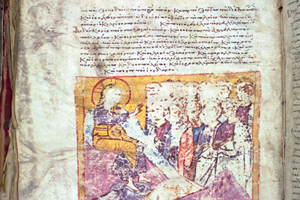Teaching to the text
By Elizabeth Station
Image credit: Goodspeed Manuscript Collection, ms950-26, Special Collections Research Center
A rat gnawed it. Smoke and water stained and puckered its pages. Even so, the Rockefeller McCormick New Testament remains the most valuable item in the University’s Edgar J. Goodspeed collection, a set of 68 New Testament manuscripts and 114 papyrus fragments from the fifth to the 19th centuries. The 12th-century Greek codex has “a resplendent silver cover, which means whoever produced it was very wealthy,” says Divinity School professor Margaret Mitchell, AM’82, PhD’89. With more than 90 illuminations, “it’s one of the most heavily illustrated Byzantine manuscripts in existence. The quality is also quite beautiful, although there has been a fair amount of deterioration.”

For Mitchell, Manuscript 965 is also a valuable teaching and research tool. Chicago students—and anyone with Internet access—can study the volume online. The library began digitizing the collection in 2003 and is two-thirds finished with the project, which allows browsing and zooming within manuscripts and across the collection. Still, “it’s never been our intention that the digital would replace the original,” says Mitchell, who brings Biblical Greek and Hebrew students to the Special Collections Research Center for a “personal encounter” with the fragile texts. “When you hold a manuscript in your hands,” she says, “when you touch its pages, you’re also in a kind of tactile engagement with all the hands that have touched it.”
Yet many hands make inevitable damage. In a brilliant color depiction of the Beatitudes (at right), Jesus’s visage is rubbed away, perhaps by an Orthodox monk who touched it as he prayed. “Every time we open the Rockefeller McCormick, there is a loss of gilt and pigment,” admits Mitchell, who believes the benefits of teaching from an original manuscript outweigh the costs: students consider not only language but also social history, literary culture, and “how reading practices and physical format are part of the interpretation of the text.”
A Christian hermeneutics expert who used the Goodspeed collection to research the Gospel of Mark, Mitchell argues that the early Christians’ use of the more portable codex (rather than the scroll) and the gathering of the four gospels into a single volume constituted a media revolution. “My own take on early Christianity is that it was a very bibliophilic cult,” she says. “They loved books, and they literally wrote their way into history.”
